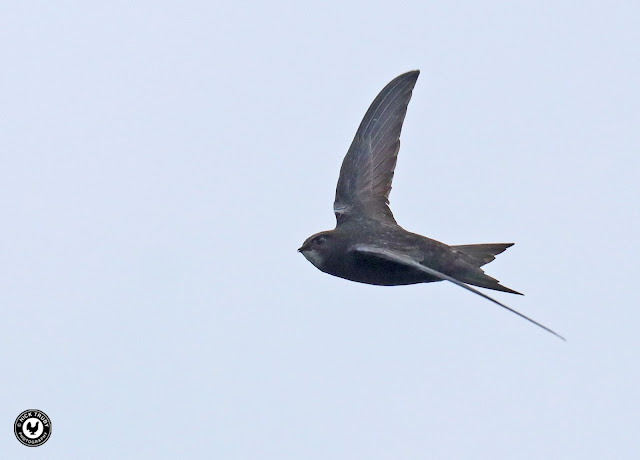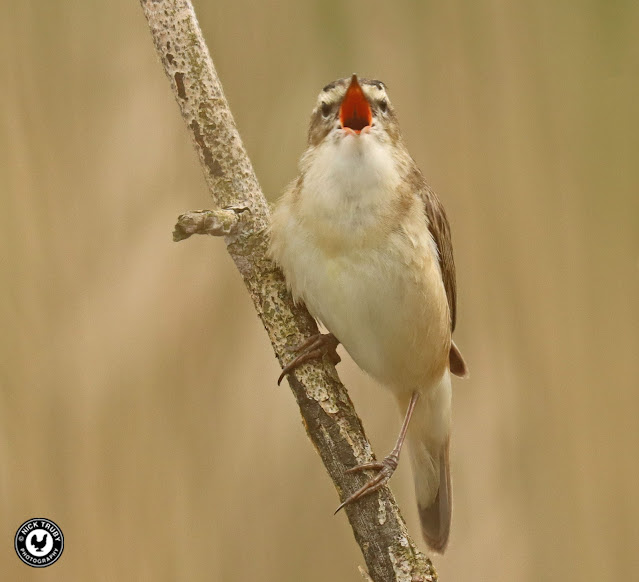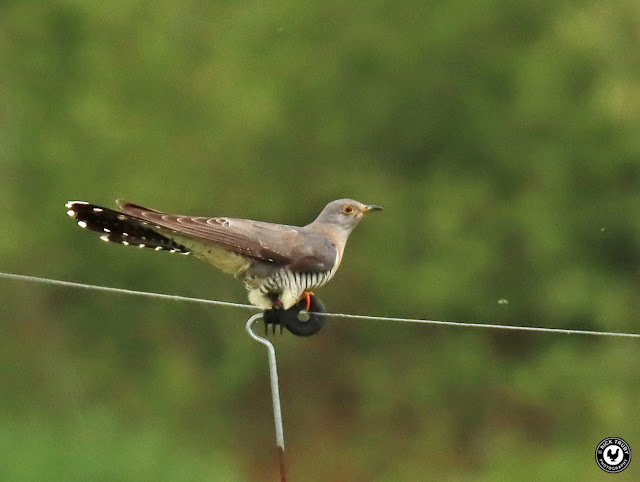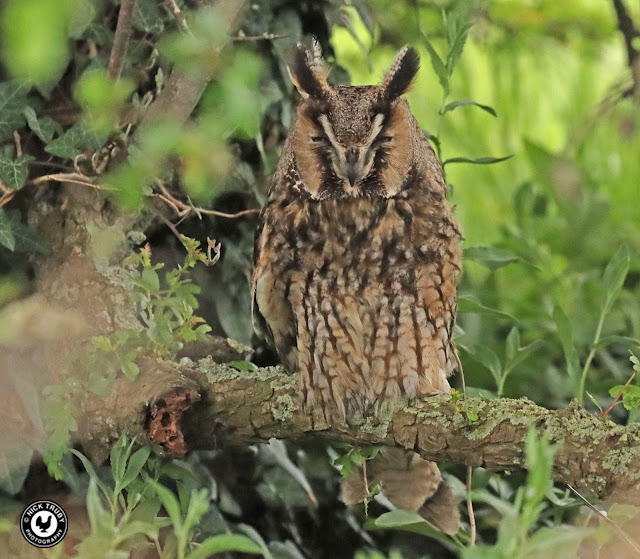Sunday 1st May; Farmoor than Usual
It's that ticking time of year, probably the busiest time for adding birds to the list apart from the first few outings and when on holidays taken in different parts of the country. We'd added fifteen birds to our year list in the last 13 days of April and we should be able to add a similar number over the next few weeks too. We chose Farmoor to kick off the month and were on site as soon as the gates opened. A few of our Oxon peers were also already there so the reservoir would get good coverage. The weather was a bit dreary with drizzle being borne along on a fairly strong breeze.
There was one species that I was hopeful of seeing on this walk, one of my favourites, and I could see some as we arrived at the embankment. We'd get to them later though. Our walk at Farmoor always starts with a stroll down the causeway, the road that divides the two basins. From the causeway you can see both ways and study birds on both F1 and F2. We couldn't see anybody else, the others had selected other routes it seemed, so it was us that surprised a pair of small waders from the concrete edge of F2. I quickly snapped a couple of shots as they flew but I already knew that they were Sanderling, our first for the year and right on the due date. The two birds alighted further along the causeway so we'd encounter them again and would be more careful next time so that I could get some proper photos.
 |
| Sanderling |
We stopped to admire a pair of Great Crested Grebes that were looking as if they might perform their wonderful courtship display but they must have got stage fright and after a few minutes of posturing they swum off in different directions. A rather smart but menacing looking Great Black-backed Gull flew past, my guess was that it was a fourth calendar year bird, yet to moult into adulthood but I'm not a Gull expert and frequently get ID's and especially ages wrong.
 |
| Great Crested Grebe |
 |
| Great Black-backed Gull |
Four Common Sandpipers formed the next flypast as they bombed by heading back to the marina over F1. Common Sandpipers are virtually impossible to witness close up at Farmoor, unlike when on their breeding grounds, and are usually only seen as they fly from one part of the reservoir to another or viewed distantly when stood on one of the rafts. Not a year tick this time, we saw our first back in January and found one here at Farmoor a week before too, but numbers will build up until they move off north for the summer.
 |
| Common Sandpiper |
A Grey Heron flew over F2 attracting the attention of some of the resident Gulls. As it traversed the reservoir it was harassed by Black-headed and Herring Gulls, particularly the latter who didn't let up until the Heron was away over Shrike Meadow.
 |
| Grey Heron & Herring Gulls |
We caught up with the Sanderling again and this time managed to observe them without flushing them further. Both of the birds were transitioning into their splendid summer breeding plumage with one slightly more advanced than the other. We watched them scampering along the waters edge for a while before giving them a wide berth and continuing to the end of the causeway.
 |
| Sanderling |
The bird that I'd been so keen on seeing had been the Common Swift, and there were maybe as many as a hundred dashing around the reservoirs. I adore Swifts, I find them one of the most charismatic of all birds and marvel at their almost completely airborne lifestyle. Swifts only land to nest and breed and fledgling birds can stay in the air for over two years after leaving the nest, leading their whole lives in the air, feeding on insects, drinking from raindrops and even sleeping whilst up there! They are incredible. I would spend hours and hours wasting shot after shot trying to photograph them. A good job that I have Mrs Caley to pull me away when I become too engrossed in aiming my camera skywards.
 |
| Common Swift |
We weren't intending to stay long so returned the way we had walked, spotting the Sanderling again which were being pushed around by the walkers and other birders that had arrived later. I got a call from Andy who had seen two Sandwich Terns drop in from high and land on a buoy at the western end of F2. Thanks to him I was able to get the scope, luckily I'd carried it for once, onto the birds and another year tick. We'd see Sandwich Terns in a few places during the summer but it's always good to get a year tick, whatever the view.
Another year tick, the fourth of the morning, came in the form of three Yellow Wagtails that were hunting flies along the causeway. They were joined by several Pied Wagtails and best of all, a White Wagtail, the continental version of the Pied. Not a year tick though because White and Pied are the same species. It was however, good to compare the two side by side.
 |
| Yellow Wagtail |
 |
| White Wagtail |
Year List additions;
202) Sanderling, 203) Common Swift, 204) Sandwich Tern, 205) Yellow Wagtail
Monday 2nd May; Farmoor Again and a Bittersweet Slice of Luck!
Reports of Arctic Terns at Farmoor saw us return to the reservoir after work to try and add them to the year list. We know that we'd see lots of them later in the summer on our Scotland holiday but it is always good to see some locally. It was intended to be a quick visit so apart from stopping to admire a couple of Yellow Wagtails at the top of the causeway we headed straight down the road where we could see a couple of friends further down, presumably watching the Terns.
 |
| Yellow Wagtail |
The reservoir was becalmed on a warm and sunny evening, unusual then that Arctic Terns should be present since we normally see them at Farmoor on windy days. We drew alongside Jeremy and Paul, both expert birders, and with their help initially picked out at least five Arctic Terns mixed in with a dozen or more Common Terns. All the Terns were fairly distant across F1 but good views were obtained.
 |
| Arctic Tern |
A shout from Jeremy had us looking skywards, three Whimbrel were flying across F1 in a northerly direction. Another year tick and a good one too since we can struggle to see Whimbrel in some years. We watched the trio of wading birds cross the reservoir hoping that they would land on the northern shore but unfortunately they kept going northwards. As we returned along the causeway we noticed that the incredibly long staying Great Northern Diver was still present too, not close in this time though.
Just as we reached our car, ready to return home I received a text message from a good friend of mine. Attached to the message was a photo of an Owl. My friend wanted to know what type it was and in another message that came in instantaneously related that he'd just found it by the side of a busy road. It had presumably been hit by a passing vehicle. The Owl in question was a Long-eared Owl, an amazing record for Oxfordshire! I then received a video which showed the Owl had managed to clamber up into a roadside hedge so at least it was out of danger and appeared unharmed. My mate had to leave the site but told me where it was, it would be a thirty-minute drive from Farmoor but that was a no brainer since this was a Long-eared Owl in our home county and would be a county tick. Provided the Owl was still present of course by the time we got there.
I had received full details of the place where the Long-eared Owl had been found. There was a couple of big problems however, it was a very busy road with traffic speeding along and there was nowhere to park at the spot. Thanks to my friend's accurate description we found the place easily enough but couldn't stop because of other road users. We spun the car around in a junction and again in a farm entrance and drove past more slowly a second time. There was momentarily no traffic so I pulled in tight and scanned the opposite roadside hedge for the Owl. It wasn't where it had been in the video and photos but after a few seconds of careful scrutiny I found it perched on a thick horizontal branch of a tree just a few metres away from the road. It had found cover and appeared to be okay. I took a couple of record shots through the car window.
 |
| Long-eared Owl |
Parking the car on a small lane about a hundred metres away, I walked along the road, often having to skip up onto the verge to avoid being annihilated by a speeding motorist, back to where the Owl was. Staying on the opposite side of the road I made a visual check of the bird which appeared to be unscathed. Its ear tufts were erect which is an indication of alarm but its eyes were closed so for now it appeared to be comfortable enough. Once back at the car I made a couple of phone calls to eminent county birders and asked for their advice. The consensus was to leave the Owl where it was and to see if it was still there the following morning. One of the chaps, who lived close by, agreed to come out and check the Owl that evening and also to recheck again in the morning. It was agreed not to broadcast the news to other birders for several reasons not least of which was that we felt that the Owl shouldn't be disturbed. It was also a very dangerous place to view from and there was only maybe an hour of light left anyway so it was unlikely anybody else would get there quickly enough unless they lived nearby. There was also the possibility that the Owl could have been a local breeding bird. So apologies to any local birders who would have liked the chance to see the Long-eared Owl but it just wasn't possible. The Owl wasn't there the following morning so hopefully it had recovered and flown off by its own accord once able to. The Owl wasn't a year tick for me, I'd already seen one in February in Cambridgeshire but it was a bittersweet county tick and my 239th species seen in Oxon.
Year List additions;
206) Arctic Tern, 207) Whimbrel
Friday 6th May; Lunchtime Delight at BQR
Late on Friday morning one of the Banbury birders visiting the Banbury Ornithological Society's excellent Balscote Quarry Reserve posted a photo of a wading bird and asked for identification. It was a Wood Sandpiper, needed for the Old Caley year list. Luckily I had just finished the day and I was close to home so I collected Mrs Caley and drove straight to the reserve. Just as well I did because the Wood Sandpiper was still present, it had been a little over an hour since the news was shared, but disappeared northwards just ten minutes after we got there. Phew!
 |
| Wood Sandpiper |
Year List addition;
208) Wood Sandpiper
Saturday 7th May; The Long Stayer!
With nothing better to do and an important date for later in the day, we decided on a gentle stroll at Farmoor again. In contrast to our visit on Monday the weather had turned from calm to quite breezy. It was a big disappointment then to find no birds of interest as we walked along the causeway apart from a few of the regulars. The only photos I took on the outward leg of the walk down the causeway were of a pair of Great Crested Grebes, possibly the same pair as on Monday, who were not really bothered with nuptial activity and a comical Coot which had tugged free a small plant from the embankment and was swimming across to the pontoon in the north-west corner of F2 to reinforce its nest.
 |
| Coot |
The day would probably have been an almost complete non-event if it hadn't been for one of the fisherfolk. The anglers at Farmoor are quite often the target of my derision, especially when they hire boats in order to fish the middle of the reservoir and then end up mooring just metres out from the banks. So I was initially very annoyed when I saw that a couple of them had parked their boat right next to the pontoon and almost on top of the nesting Coots. When I saw one of them snare their fly into the wire cage I laughed. When the angler climbed out onto the cage to untangle his hook and line I was far less amused but the sitting Coot stayed put and was obviously less bothered than I was.
After the chap had retrieved his tackle and had climbed back into the boat, a familiar shape had amazingly appeared as if from nowhere on the water about twenty metres out from the pontoon. The long staying juvenile Great Northern Diver (GND), it had first been seen in December last year and had been present ever since, was floating on the water and looking back towards the anglers in the boat and the pontoon. There had been no sign of the Diver at all before that point. I hatched a theory. I reckon that the Diver was using the pontoon (basically a caged structure that contains barley straw which acts as an algae suppressant) as a resting spot, probably swimming underneath it and accessing a void beneath the cages. When the angler clambered about on the top of the cages, the bird was disturbed and hence emerged as if by magic. I'm probably wrong but hey, it had to come from somewhere.
 |
| Great Northern Diver |
Now that the Great Northern Diver was active it went on to treat us to possibly our best views of it, and we'd already had several terrific encounters with it over the past few months. Over the next forty-five minutes the bird made several close approaches to the bank and even ventured inside the small enclosure created by the pontoon. At times the bird came so close to the bank that it could be seen swimming underwater as it hunted for its favourite Crayfish prey. It didn't have any luck though unless it was eating while submerged.
The Diver, as the name suggests, is very adept at diving and not for the first time I began measuring the time it was underwater, usually around 60-80 seconds. We also attempted to predict where it would surface next, and that could be as much as 50 metres away. Helpfully, the GND remained close to the causeway so when it resurfaced carrying a Crayfish in its massive bill, I was able to get some decent photographs. The GND liked to detach the large pincer claws of the crustacean before eating it and that would involve bashing it onto the water with gusto and the use of the bill as a huge pair of scissors. Once the pincers were severed then the Diver would manipulate what was left of its snack, dip it into the water a few times and swallow.
After each meal there was a period of cleansing, head dipping and shaking, presumably to get rid of Crayfish slime and other unsavoury stuff. No lengthy digestion though for the GND was straight back under and looking for more sustenance. After watching the Diver catch and despatch a few Crayfish, Farmoor fisherfolk and Thames Water should be grateful for the birds efforts in reducing the population of the invasive crustaceans, it disappeared as mysteriously as it had appeared. Unless the Diver is capable of swimming for half a mile underwater, it had to have returned to underneath the pontoon again since there was no sign of it anywhere on the reservoir.
We walked back to the car stopping only to photograph a stunning drake Mallard and a flyover Great Crested Grebe. Great Crested Grebes (GCG) are the oddest looking birds in flight, with seemingly impossibly small wings bearing a long and gangly frame as they hurtle over the reservoir. As odd as they look though, GCG are adequate fliers and make long journeys at migration times. However, they do look far more at home on, and in the water than they do flying above it.
 |
| Mallard |
 |
| Great Crested Grebe |
Sunday 8th May; Another Showy Reggie!
Although I knew it wouldn't last, we were enjoying the local scene for a while. It wouldn't continue because sooner or later there would be some enticing birds further afield which we wouldn't be able to resist, and our three week journey up to Northumberland and Scotland was creeping closer. On this initially overcast but later sunny morning, we were out early on Otmoor to see if any more of our summer breeding birds had arrived. As early as we were, Mark, not called The Early Birder for nothing, was already stood on the bridleway as we approached. He had set up his stall opposite a small bare tree between the path and the ditch that borders Greenaways to the South. We inquired what he was hoping for but before he could tell us the Sedge Warbler that crept up the tree and began singing answered our query for him.
 |
| Sedge Warbler |
For the next half an hour the three of us watched the Sedge Warbler perform a one bird concert and two of us took photo after photo after photo. Nobody else walked up to disturb anything. Last year there was an equally showy Sedge Warbler by the River Thames at Farmoor which was christened "Reggie the Sedgie". Now here, was another Reggie and he was a worthy contender to last years bird. It would have been easy to stay all day taking the birds mugshot but thankfully I have Mrs Caley to remind me that there are other birds on Otmoor that we could see and others that we could hear, such as a Grasshopper warbler, and not see.
A bird that we hoped to see was a Hobby and as we walked along the bridleway we spotted two flying low across Greenaways. Hobbies and my camera are not best friends and I consistently fail in my best efforts to secure good images of them. So I had to be happy with yet another record shot of the latest addition to the year list.
 |
| Hobby |
Several Cuckoos were present on the Moor and we watched them career along the bridleway and listened to the calls emitted whenever they settled in the trees. Getting close to Cuckoos is never easy (unless you go to Thursley for the hand fed and tame "Colin" which isn't for me), they always have the edge and will fly just as you get the chance to take a shot. So when Mrs Caley spotted one high up in one of the Oak trees opposite the Wetlands Hide, I crept up as stealthily as I could and managed a couple of photos before the bird sprung from the tree. It landed on the fence bordering Big Otmoor allowing for a couple more images. Not close and wonderful but better than my normal poor attempts at capturing a Cuckoo.
 |
| Cuckoo |
We moved on to the first screen and peered out at the few ducks that were foraging there. A familiar pale shape caught our eye. "Luke" the partially leucistic (or reduced pigmentation or something or other, I can never remember exactly) drake Pochard had returned again for another spring. This striking duck has been seen on the Moor for six years now although he never stays for long. For once he was quite close in and we got to watch him ducking and a diving.
%2012.jpg) |
| Pochard |
There was another bird of note on the Moor that had been seen for a week or so, and we spotted the Spoonbill as we rounded the bend on our way back to the bridleway. We had actually seen it as we walked past Greenaways but then it was at great distance, now the Spoonbill had moved to Big Otmoor and was showing much better. Spoonbills are quite scarce in Oxon and in fact this was the first one that I'd seen on the ground in the county.
 |
| Spoonbill |
There are two pairs of Common Cranes around Otmoor and one pair have bred and hatched two young. Because the young are still small, they are elusive and keep to long grass and ditches so are seen infrequently. The other pair announced their presence with their bugle type calls and we spotted them flying eastwards over the Northern lagoon some half a mile away. Fingers crossed for the young ones.
 |
| Common Crane |
A quick stop to take another look at Reggie the second who was still entertaining all of those that noticed him and then it was home after a pretty good morning spent in one of our favourite places.
Year List addition;
209) Hobby
Tuesday 10th May; A Near Miss but a Chance Encounter Instead
A Turtle Dove had been spotted by the Wetlands Hide on Otmoor, feeding alongside the Finches and Buntings on the winter food supplement that is put out for them. Until recently Otmoor was famous for its breeding Turtle Doves but the last couple of years had seen them disappear from the Moor. The pressures of hunting on the continent seem to be accelerating their demise as a UK bird. They are still found relatively easily in the east of the country but numbers are falling rapidly. So to hear of one on Otmoor again was exciting!
My big mistake was taking it too easy after work and not going out to the Moor until after tea. Our friends Kev & Karen had gone straight out there after his working day and connected with the bird. He was still there when we arrived and confirmed that the Dove was still feeding as we left the carpark. By the time we reached the hide some twenty minutes later it had flown into one of the large Oaks on the bridleway and despite much searching in the trees we couldn't find it again. A lesson then to forget the belly in future and get straight out. One I'll never learn. I like my food.
We gained plenty of compensation though just minutes after Kev & Karen had left when I found a beautiful Tawny Owl in a small Oak close to the hide while scanning for the Turtle Dove. We'd heard Tawny Owls on the Moor before but this was the first that we'd actually seen. Although partially obscured in the foliage, the late evening light helped produce a few lovely images.
 |
| Tawny Owl |
The Turtle Dove was seen on the following day, Kyle (Birdwatch Britannia) saw it, but not subsequently so we'd have to work a bit harder still to get one on to our year list.





































%203.jpg)
%208.jpg)


